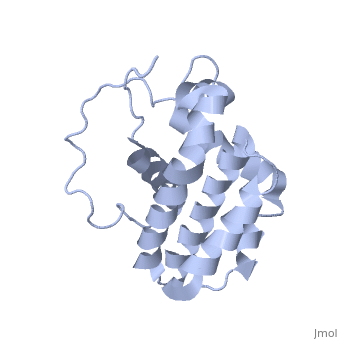Sandbox Reserved 1122
From Proteopedia
(Difference between revisions)
| Line 36: | Line 36: | ||
The posttranslational modifications found on the loops between BH3 and BH4 modify the anti-apoptotic activity of Bcl-2. Hence, the Bcl-2 binding to NALP1 can be affected by these modifications. <ref>[http://www.sciencedirect.com/science/article/pii/S0092867407003042 Bcl-2 and Bcl-XL Regulate Proinflammatory Caspase-1 Activation by Interaction with NALP1] </ref> | The posttranslational modifications found on the loops between BH3 and BH4 modify the anti-apoptotic activity of Bcl-2. Hence, the Bcl-2 binding to NALP1 can be affected by these modifications. <ref>[http://www.sciencedirect.com/science/article/pii/S0092867407003042 Bcl-2 and Bcl-XL Regulate Proinflammatory Caspase-1 Activation by Interaction with NALP1] </ref> | ||
| - | == | + | == Diseases == |
| + | |||
| + | === Cancer === | ||
| + | BCL-2 is involved in many cancers such as breast, melanoma, prostate, chronic lymphocytic leukemia and lung cancers. In fact, its overexpression combined with an overexpression of c-Myc (another oncoprotein) produce aggressive B-lymphocytes. <ref>[http://www.bloodjournal.org/content/125/4/658 BCL2 mutations are associated with increased risk of transformation and shortened survival in follicular lymphoma]</ref>. It has also be shown that BCL-2 overpexpression supresses DNA repair by enhancing Myc transcriptional activity. | ||
| + | <ref>[http://www.jbc.org/content/281/20/14446.full Bcl2 Suppresses DNA Repair by Enhancing c-Myc Transcriptional Activity]</ref> In fact, BCL-2 is encoded by the BCL-2 gene (0,20 Mb) located on the 18th chromosome. Nevertheless, translocation between chromosome 14 and 18 juxtaposes the BCL-2 gene and the immunoglobulin locus. This brings the BCL-2 gene under the regulation of the immunoglobulin heavy-chain enhancer, diregulating BCL-2 expression level (involved in non-Hodgkin's lymphomas). <ref>[http://www.nature.com/onc/journal/v27/n50/full/onc2008307a.html Bcl-2 family proteins and cancer]</ref> | ||
| + | Other mechanisms appear to regulate and enhance the level of expression of BCL-2 : loss of endogenous microRNAs which normally repress BCL-2 expression, and also hypomethylation.<ref>[http://www.nature.com/onc/journal/v27/n50/full/onc2008307a.html Bcl-2 family proteins and cancer]</ref> | ||
| + | |||
| + | BCL-2 BH4 domain mediates the interaction with MBII domain of Myc. This interaction enhance c-Myc half-life, resulting in an enhancing of its total activity. c-Myc is a well known oncoprotein (transcription factor) involved in many cancers as it regulates a lot of genes of the cell cycle. | ||
== Relevance == | == Relevance == | ||
Revision as of 17:13, 28 January 2016
| This Sandbox is Reserved from 15/12/2015, through 15/06/2016 for use in the course "Structural Biology" taught by Bruno Kieffer at the University of Strasbourg, ESBS. This reservation includes Sandbox Reserved 1120 through Sandbox Reserved 1159. |
To get started:
More help: Help:Editing |
HUMAN BCL-2, ISOFORM1
| |||||||||||
References
- ↑ Hanson, R. M., Prilusky, J., Renjian, Z., Nakane, T. and Sussman, J. L. (2013), JSmol and the Next-Generation Web-Based Representation of 3D Molecular Structure as Applied to Proteopedia. Isr. J. Chem., 53:207-216. doi:http://dx.doi.org/10.1002/ijch.201300024
- ↑ Herraez A. Biomolecules in the computer: Jmol to the rescue. Biochem Mol Biol Educ. 2006 Jul;34(4):255-61. doi: 10.1002/bmb.2006.494034042644. PMID:21638687 doi:10.1002/bmb.2006.494034042644
- ↑ Solution structure of the antiapoptotic protein bcl-2
- ↑ Alpha-Helical Destabilization of the Bcl-2-BH4-Domain Peptide Abolishes Its Ability to Inhibit the IP3 Receptor
- ↑ BH1 and BH2 domains of Bcl-2 are required for inhibition of apoptosis and heterodimerization with Bax
- ↑ Control of mitochondrial apoptosis by the Bcl-2 family
- ↑ Differential Targeting of Prosurvival Bcl-2 Proteins by Their BH3-Only Ligands Allows Complementary Apoptotic Function
- ↑ Distinct BH3 domains either sensitize or activate mitochondrial apoptosis, serving as prototype cancer therapeutics
- ↑ The Release of Cytochrome c from Mitochondria: A Primary Site for Bcl-2 Regulation of Apoptosis
- ↑ Prevention of Apoptosis by Bcl-2: Release of Cytochrome c from Mitochondria Blocked
- ↑ Bcl-2 and Bcl-XL Regulate Proinflammatory Caspase-1 Activation by Interaction with NALP1
- ↑ BCL2 mutations are associated with increased risk of transformation and shortened survival in follicular lymphoma
- ↑ Bcl2 Suppresses DNA Repair by Enhancing c-Myc Transcriptional Activity
- ↑ Bcl-2 family proteins and cancer
- ↑ Bcl-2 family proteins and cancer

